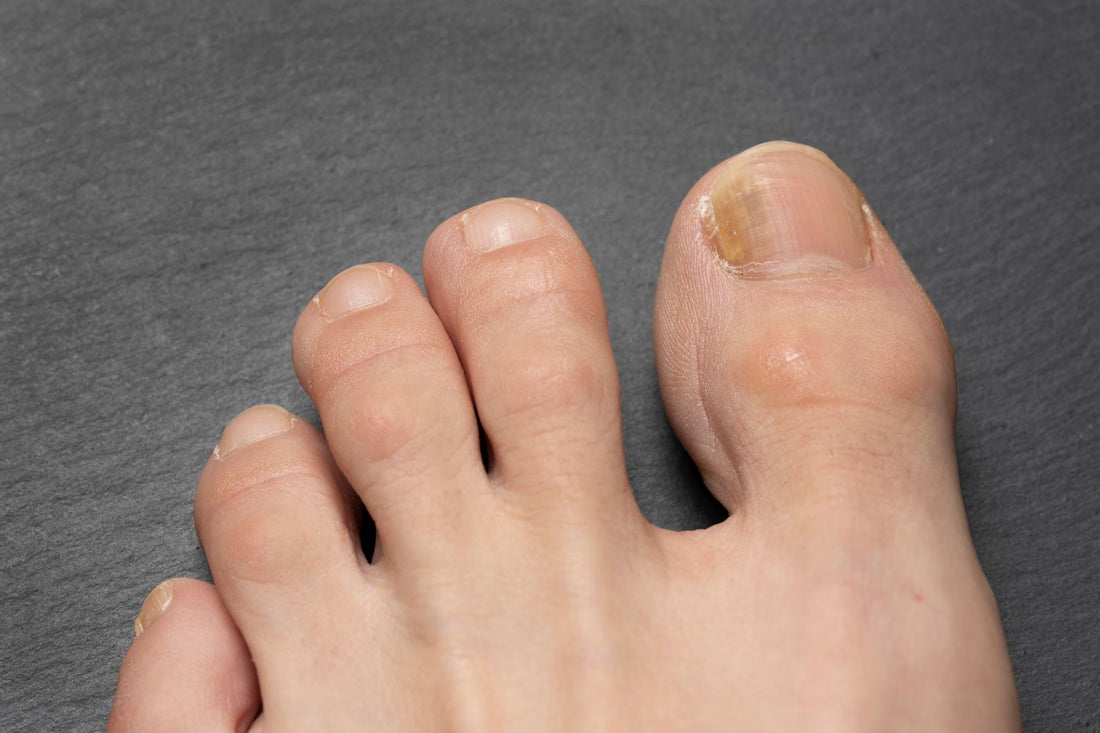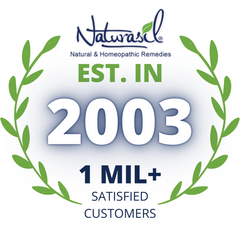What is a fungal nail infection?
Tinea unguium is the name for a fungal nail infection, usually found on the toenails. This condition is caused by a kind of fungus called dermatophytes (most commonly, these are two strains of fungi known as Trichophyton rubrum and Trichophyton interdigital). [1]These two types of dermatophytes cause between 80 and 90% of fungal nail infections; with the remainder caused by the overgrowth of a kind of yeast. [2]
The dermatophytes thrive by consuming the keratin in your nails. When the fungi invade your nail through the hyponychium (the skin at the top of your toenail, where the nail detaches from the nail bed) and are allowed access to the nail—usually through some damage to it—you may start to see symptoms of tinea unguium. [3]
Though fungal nail infections are not usually serious, they can be extremely unpleasant - and in some cases, they can be related to other cases of fungal infections, too. The symptoms of tinea unguium are the outward signs of the fungal nail infection, and the dermatophytes will continue to live in your nails—and possibly spread to others—until they are properly treated. Tinea unguium recurs in up to 50% of cases, too, so proper preventative measures are essential to keep your nails fungus-free.
Symptoms of a fungal nail infection
Aesthetically, there are two common varieties of tinea unguium, each with its own symptoms. In the first kind - medically known as distal or lateral subungual onychomycosis - you will first notice a discoloration of the affected nails. This particular strain of tinea unguium affects the deeper layers of your toenails, and the symptoms can be quite severe as a result. Your toenails are likely to turn yellow or white, starting in a small patch that will spread over time. In rarer cases, the infection may cause your toenails to turn brown or black. Sometimes, your nails might get thicker in places or start to crumble, appear split, or damaged, and they might detach from your nail bed, too. [4] This can cause swelling and pain on the skin around the toenail.
The other aesthetic symptom of a fungal nail infection is an opaque, white formation on your nails that can make them look cloudy. In the case of this kind of fungal nail infection - medically known as white superficial onychomycosis - the dermatophytes have invaded the top layer of your toenail (the dorsal layer). If this white fungal growth can be scraped away, it suggests that the dermatophytes are affecting only the upper, superficial layers of your nail. If the growth cannot be scraped away, then the dermatophytes have started penetrating deeper into the nail. [5]
It is most common for your big toenail to be affected first, but the infection is likely to spread to other toenails, particularly if they are damaged, too. [6] Though it is rare for fungal nail infections to affect fingernails because fingernails have a better blood supply and grow faster, it is possible, especially if you pick at your affected toenails with your fingernails. [7]
What causes a fungal nail infection?
There are many ways in which one can contract a fungal nail infection. Some of the most common risk factors are:
- Pre-existing damage to the nail or nail bed. This is because damage to your nails makes the surface of the nail easier for the dermatophytes to penetrate.
- A case of tinea pedis (more commonly known as athlete’s foot). If you have a case of athlete’s foot, dermatophytes are already living on your feet and thriving in your socks, so your toenails are more likely to be vulnerable to fungal infection.
- Walking barefoot on damp, communal surfaces where another person with the condition has deposited their own dermatophytes, common culprits include locker rooms, public pools, and communal showers. Dermatophytes thrive in warm, moist environments, so you are more likely to pick them up here.
- Sharing towels, bedding, clothes, shoes, and nail clippers or scissors with a person who has a fungal nail infection. Dermatophytes can live on hard and soft surfaces for significant periods, so you are more likely to pick them up if you are near someone with an existing case of tinea unguium, sharing a bed, towels, or clothes with them.
One study found that men are more likely to get a fungal nail infection than women. This is thought to be because men are more likely than women to frequently wear damp or sweaty socks and closed-toe shoes. These are two significant causes of fungal infections on feet and toenails, as the dermatophytes thrive in moist, warm conditions. Additionally, men are reportedly more likely to suffer damage or trauma to the nails or nail bed. [8] Because the fungus that causes this nail infection likes to live inside your nail, it is likely to enter your toenail if you have damage to your nails. So, if your toenails are split or damaged and come into contact with dermatophytes, you are more likely to contract a fungal nail infection of your own. This can also be the case if you regularly get pedicures, since some of the products and techniques cause damage to the nail or nail bed.
The likelihood of contracting a fungal nail infection increases with age, too. Though children do sometimes contract a fungal nail infection, it is much more common in older adults. [9] In fact, while 10% of the general population will have a fungal nail infection at any one time, this increases to 20% of people who are over 60 and half of people in the 70+ age bracket. [10] This is likely because the growth of nails slows with age, and older people are more likely to suffer nail trauma, too. [11]In addition, smokers are also more likely to develop a fungal nail infection. [12] This is due to the damage that the chemicals in cigarettes do to the nails.
How to treat a fungal nail infection
When it comes to treating your fungal nail infection and avoiding a recurrence of the condition, a consistent and targeted approach is key. The Naturasil Nail Fungus Treatment Bundle offers a complete and comprehensive solution to tinea unguium, with all-natural ingredients that are clinically proven to effectively target your fungal infection at the source. Using our natural, homeopathic remedies ensures that your treatment is safe by avoiding the harsh chemicals present in many over-the-counter remedies and their associated side effects.
The Naturasil bundle consists of two products: our Nail Fungus Medicated Soap and our Nail Fungus Oil. The soap uses a gentle yet effective combination of natural antifungal ingredients and essential oils that combat the fungus in your nails while deeply cleansing and enriching your skin. Washing your nails, fingers, and toes thoroughly at least twice daily for 4–10 days will target the nail fungus, preventing further growth and stopping it from spreading. Once the nail has grown out completely, symptoms of the fungal infection will disappear. Continued use of the soap will have a preventative effect.
For a thorough treatment, use our Nail Fungus Topical Oil on the affected areas of your nails. The oil is easy to apply with the applicator brush, offering a targeted solution that complements the wider effects of the soap. You should apply the oil three times per day until the fungus is gone, and the oil should be applied on the top of the nail and underneath it where possible. The natural fungus oil will improve your nail health and reduce the discoloration caused by tinea unguium, with results in as little as two weeks. Treatment should continue until the nails are entirely fungus-free to prevent a recurrence of the condition.
There are plenty of measures you can take to prevent recurrent cases of tinea unguium. These include treating other fungal conditions - particularly tinea pedis (athlete’s foot), as soon as possible. Our Tinea Value Pack contains two products that effectively target current cases of athlete’s foot and, when used consistently, prevent its recurrence. The Sulfur Lavender Soap harnesses the natural antifungal properties of sulfur to cleanse the affected areas, while lavender oil provides lasting freshness. Our Tinea Topical Oil provides a strong, targeted approach to combating the fungal infection at its source. It relieves itching and discomfort while the infection heals.
Further cases of fungal nail infections can also be prevented through a determined approach to hygiene and nail care. Try to keep your feet clean and dry as much as possible, and wear clean, fresh socks daily to avoid the warm, moist conditions in which dermatophytes can multiply. Keeping your toenails short can also help to protect the hyponychium, the part of your toe that is vital to keeping bacteria and other microbes out of your toenails. It can help to wear open-toe shoes to increase the air circulation around your nails and avoid narrow and high-heeled shoes, as these can restrict, put pressure on, and damage your toenails. Avoid wearing old shoes and sharing foot and nail care products with anyone else with the condition. After treating your fungal nails, make sure to clean your toenail scissors or clippers thoroughly to avoid reinfection.
[1] Asz-Sigall, D., Tosti, A., and Arenas, R. (2017). ‘Tinea unguium: diagnosis and treatment in practice.’ Mycopathologia, 182, 95–100.
[2] Perea, S., Ramos, M.J., Garau, M., Gonzalez, A., Noriega, A.R., and del Palacio, A., ‘Prevalence and risk factors of tinea unguium and tinea pedis in the general population in Spain.’ (2000) Journal of Clinical Microbiology, 38(9).
[3] Piraccini, B.M., and Alessandrini, A. (2015). ‘Onychomycosis: a review.’ Journal of Fungi, 1(1), 30-43.
[4] Ibid.
[5] Ibid.
[6] Perera et al., 2000.
[7] Westerberg, D.P., and Voyack, M.J. (2013). ‘Onychomycosis: current trends in diagnosis and treatment.’ Am Fam Physician, 88 (11), 762-770.
[8] Perera et al., 2000.
[9] Gill, D., and Marks, R. (2002). ‘A review of the epidemiology of tinea unguium in the community.’ Australasian Journal of Dermatology, 40(1), 6–13.
[10] Westerberg and Voyack, 2013.
[11] Perera et al., 2000.
[12] Westerberg and Voyack, 2013.








